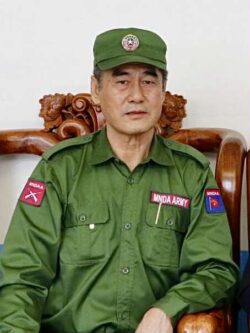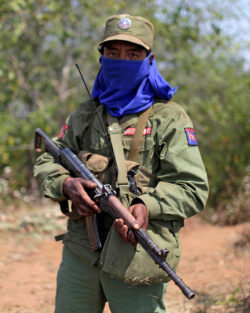The Myanmar National Democratic Alliance Army (MNDAA)

One of my collecting interests are the insignia worn by various insurgent groups and guerilla armies and Burma/Myanmar is a country of particular interest to me. The Myanmar National Democratic Alliance Army (MNDAA) is one of many armed factions fighting in Myanmar. Fighting has intensified since the coup of 2021 but it is not new. These groups which are motivated by a mix of ethnic autonomy, political power struggles, and control over lucrative illicit drug trade revenues, often funded through narcotics trafficking, arms sales, and foreign support have often developed significant military capabilities in support of their aims.
Myanmar, upon gaining independence in 1948, was envisioned as a unified nation with autonomy for its diverse ethnic groups, as outlined in the 1947 Panglong Agreement. However, this promise of autonomy for groups like the Shan, Karen, Rohingya, Rakhine, Wa, Mon, Shan and Chin was not realized due to the assassination of the agreement’s architect, Aung San, and subsequent political instability that followed. This led to ongoing ethnic tensions and conflicts, particularly between the dominant Burman (Bamar) group and the minority ethnic groups.
The Myanmar National Democratic Alliance Army (MNDAA) has long been a significant actor in the broader ethnic insurgency landscape of Myanmar, fighting for the autonomy and rights of the Kokang people in northern Shan State. Over the years, the MNDAA has navigated complex political and military terrain, not only in its pursuit of greater regional autonomy but also as part of larger ethnic armed coalitions and its role as a buffer between China and Myanmar. Most notably, it has been a member of the Federal Political Negotiation and Consultative Committee (FPNCC), an alliance formed in 2017 to unite several major ethnic armed groups under a shared goal of resistance to the central government.

The MNDAA’s Historical Evolution
Formed in 1989 by ethnic Chinese rebels following the collapse of the Communist Party of Burma (CPB), the MNDAA has largely focused on defending the Kokang people against the central government’s military and political encroachments. The MNDAA’s early years were marked by military engagement with the Myanmar Army (Tatmadaw), particularly as the central government demanded ethnic militias to integrate into its Border Guard Forces. When the MNDAA resisted this demand in 2009, the Tatmadaw launched an offensive that led to the displacement of thousands and the weakening of the MNDAA’s presence in Kokang. However, after regrouping, the MNDAA re-emerged as a significant force in the Shan region, clashing with Myanmar’s military in 2015 during the Kokang Uprising.
In the years that followed, the MNDAA continued to resist government pressure while navigating shifting alliances with other ethnic armed groups, including the Kachin Independence Army (KIA) and the Shan State Army (SSA). These alliances became institutionalized in 2017 when the MNDAA joined the FPNCC, which sought to present a unified front in opposition to the Myanmar military.


The Role of the FPNCC and Recent Developments
The FPNCC, formed on April 19, 2017, represents the strongest coalition of ethnic armed groups in Myanmar. In addition to the MNDAA, it includes the United Wa State Army (UWSA), Arakan Army (AA), KIA, and National Democratic Alliance Army (NDAA), among others. The alliance has aimed at leveraging its collective military and political influence to assert greater autonomy for Myanmar’s ethnic minorities. However, as of 2025, the FPNCC faces growing challenges, including internal territorial disputes and increasing Chinese influence, which threaten its unity and future effectiveness.
One of the key challenges facing the FPNCC has been increasing intergroup tensions. In recent months, incidents such as forced removals, detentions, and the dismantling of checkpoints and outposts between the MNDAA, KIA, and the Ta’ang National Liberation Army (TNLA) have raised concerns about the cohesion of the alliance. These disputes largely stem from competition over territory and strategic advantages, exacerbated by the launch of the Brotherhood Alliance’s Operation 1027 in northern Shan State.
This situation mirrors the fragmentation of the United Nationalities Federal Council (UNFC), a previous ethnic coalition, which dissolved in 2020 due to unresolved internal problems such as coordination failures, financial difficulties, and lack of institutional effectiveness. The FPNCC risks following a similar trajectory, compounded by deeper challenges—namely, China’s growing influence and ongoing territorial disputes.

China’s Growing Influence

Unlike the UNFC, where China had limited involvement, the FPNCC has found itself increasingly under Beijing’s influence. Following the 2021 coup, China’s strategic interests in Myanmar, particularly regarding its role in the peace process and control of key trade routes, have intensified. The FPNCC, especially the UWSA, has aligned more closely with Beijing’s vision of a stable Myanmar, which includes distancing itself from Myanmar’s civilian resistance factions such as the National Unity Government (NUG) and the People’s Defense Forces (PDF).
In 2024, the MNDAA followed the UWSA’s lead, publicly announcing it would not engage with the NUG, signaling the growing role of Chinese diplomacy in Myanmar’s ethnic conflict. China’s involvement has extended to facilitating ceasefires, such as the January 2024 ceasefire agreement between the MNDAA and the Myanmar military. However, tensions have emerged within the FPNCC as China has mediated withdrawals of ethnic forces, such as the MNDAA’s retreat from Lashio city, to stabilize the military’s control over northern Shan State.
This situation is further complicated by Chinese pressure on groups like the TNLA to make similar territorial concessions. With the MNDAA’s ceasefire agreement and subsequent territorial retreat, some members of the FPNCC, particularly the TNLA, have expressed frustration, fearing a loss of strategic advantage and increased vulnerability to the military’s counteroffensives.
The Future of the FPNCC
The FPNCC’s future remains uncertain as it grapples with the twin challenges of internal divisions and external pressures. With China’s increasing role in mediating peace processes and directly influencing military and political outcomes, the alliance is at a crossroads. Not only are territorial disputes unresolved, but the alliance’s ability to hold together in the face of Chinese diplomacy, coupled with a lack of effective conflict resolution mechanisms, casts doubt on its longevity.
The internal cohesion of the FPNCC appears to be deteriorating, with reports of limited communication between its member groups since 2023. Only one summit was convened since the COVID-19 pandemic, and the slow response to territorial disputes, such as those between the MNDAA, KIA, and TNLA, highlights the alliance’s dysfunctionality.
As the FPNCC faces these mounting pressures, it is increasingly likely that it will follow the path of the UNFC and disintegrate, especially if it cannot resolve its internal territorial and leadership disputes and continues to be swayed by external actors like China.
Conclusion
The MNDAA, once a relatively localized insurgent force, now plays a central role in the broader dynamics of Myanmar’s ethnic conflict. As a key member of the FPNCC, it is integral to the shifting balance of power in the country. However, the alliance’s future is increasingly uncertain, with rising intergroup tensions and China’s expanding influence threatening to unravel the coalition. Whether the FPNCC can maintain its unity or will dissolve like the UNFC remains to be seen, but the outcome will significantly shape the trajectory of Myanmar’s ongoing ethnic conflict.
Sources:
- South, A. (2008). Ethnic Armed Struggle in Burma: A Historical Perspective. In Southeast Asian Studies.
- International Crisis Group (2015). Myanmar: The Kokang Crisis and the Growing Armed Resistance.
- Human Rights Watch (2016). Burma’s Ethnic Armies: The MNDAA and the Kokang Conflict.
- United Nations Office for the Coordination of Humanitarian Affairs (OCHA), Myanmar (2021). Kokang Region and Ethnic Conflict Update.
- Global Asia (2025). China’s Growing Influence in Myanmar’s Ethnic Insurgency and the FPNCC.

Related
The Myanmar/Burmese KNLA Insurgent Army Patch











